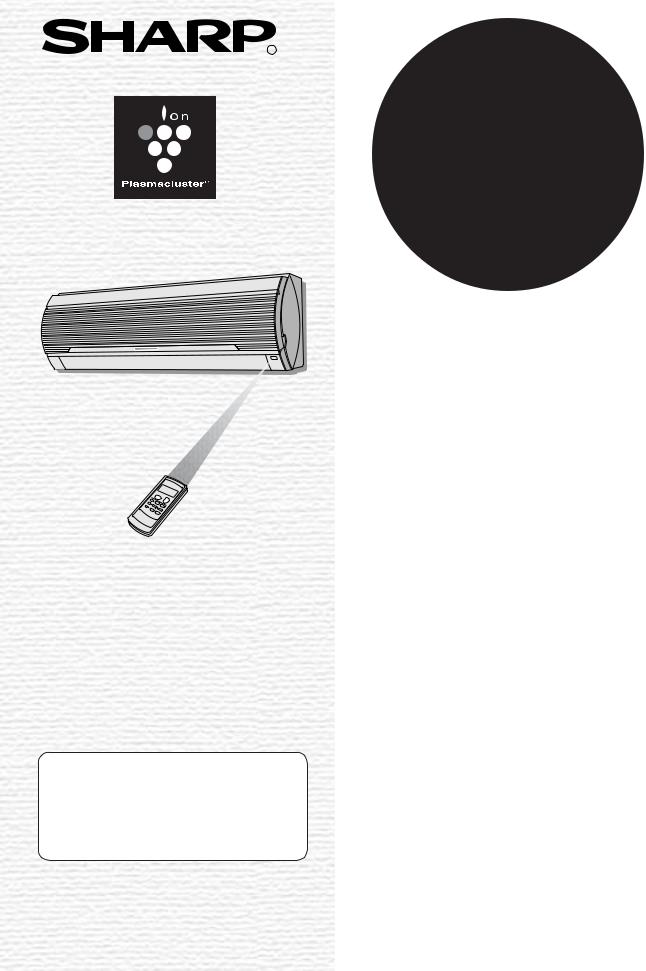Sharp AY -AP18EJ, AY -AP24EJ Operation Manual

R
AY -AP18EJ
AY -AP24EJ
SPLIT TYPE
ROOM AIR CONDITIONER
OPERATION MANUAL
•Uses ozone layer friendly refrigerant R410A.
INDOOR UNIT |
OUTDOOR UNIT |
AY-AP18EJ AE -A18EJ
AY-AP24EJ AE -A24EJ
*Plasmacluster is a trademark of Sharp Corporation.

ENGLISH
Thank you for purchasing a SHARP air conditioner. Please read this manual carefully before operating the product.
CONTENTS
..............................................• PRECAUTIONS |
1 |
........• PLASMACLUSTER OPERATION |
11 |
• ADDITIONAL NOTES ON OPERATION ........ |
3 |
• ONE-HOUR OFF TIMER ...................... |
11 |
• TIPS ON SAVING ENERGY ........................... |
3 |
• TIMER OPERATION ............................. |
12 |
• PART NAMES ................................................. |
4 |
• AUXILIARY MODE ............................... |
14 |
• USING THE REMOTE CONTROL ................. |
6 |
• MAINTENANCE .................................... |
14 |
• TIPS ABOUT PLASMACLUSTER OPERATION .... |
7 |
• BEFORE CALLING FOR SERVICE ..... |
16 |
• BASIC OPERATION ....................................... |
8 |
• SPECIFICATIONS ................................ |
17 |
• ADJUSTING THE AIR FLOW DIRECTION .... |
10 |
|
|
PRECAUTIONS
WARNINGS FOR USE
1 |
This model should be installed with a fixed power cord to the meter box. |
2 |
Be careful not to expose your body to the outlet air for prolonged periods. It may affect |
your physical condition. |
|
3 |
When using the air conditioner for infants, children, elderly, bedridden or disabled people |
make sure the room temperature is suitable for those in the room. |
|
4 |
Never insert objects into the unit. Inserting objects can result in injury due to the high |
speed rotation of the internal fans. |
|
5 |
If anything abnormal with the air conditioner (eg burning smell), stop the opertaion |
immediately and turn the circuit breaker off. |
|
6 |
This air conditioner should be installed by a licensed air conditioning contractor in |
accordance with AS/NZS 3000:2000 and your electricity suppliers rules. |
|
7 |
There are local council rules regarding maximum allowable noise levels emitted by air |
conditioners, your licensed air conditioning contractor will advise you on the correct |
|
|
location of your outdoor unit. |
8 |
Use only the manufacture-specified power cord for replacement. Replacement should be |
performed by a service centre approved by SHARP. |
WARNINGS FOR INSTALLATION / REMOVAL / REPAIR
For your safety, ensure that your new air conditioner is installed by a licensed air conditioning contractor in accordance with the AUSTRALIAN/NEW ZEALAND WIRING RULES.
•Do not attempt to install/remove/repair the unit by yourself. Incorrect work will cause electric shock, water leak, fire etc. Consult a licensed air conditioning contractor for the installation/ removal/repair of the unit.
1

PRECAUTIONS
CAUTIONS FOR USE
1 |
If a gas appliance is used in the same room as the air conditioner, ventilate the room |
periodically to prevent oxygen depletion. |
|
2 |
For safety, do not touch the unit with wet hands, it may cause an electric shock. |
3 |
For safety, turn the circuit breaker off when not using the unit for an extended period of |
time. |
|
4 |
For safety, do not place anything on top of the outdoor unit or step on it. |
5 |
This unit is designed for residential use. Do not use for other applications such as in a |
kennel or greenhouse to raise animals or grow plants. |
|
6 |
Do not block the air inlets or outlets of the unit. |
7 |
For safety, be sure to turn the unit off the circuit breaker before performing any |
maintenance or cleaning. |
|
8 |
Do not pour water directly on the unit. Water can cause electrical shock or equipment |
failure. |
|
9 |
This appliance is not intended for use by young children or infirm persons without |
supervision. |
Young children should be supervised to ensure that they do not play with the appliance.
CAUTIONS FOR LOCATION / INSTALLATION
To ensure that your warranty is not cancelled, both the indoor/outdoor units and supply/ interconnecting cables must be installed by a licensed air conditioning contractor.
•The unit is designed to operate on 230-240 VAC, 50Hz
•Do not install the unit where flammable gas may leak. It may cause a fire.
2

ADDITIONAL NOTES ON OPERATION
OPERATING TEMPERATURE RANGE
|
|
INDOOR TEMP. |
OUTDOOR TEMP. |
|
|||
|
upper limit |
32˚C |
D.B. |
46˚C |
D.B. |
||
COOLING |
23˚C W.B. |
|
- |
|
|||
|
|
|
|||||
lower limit |
21˚C |
D.B. |
21˚C |
D.B. |
|||
|
|||||||
|
15˚C W.B. |
|
- |
|
|||
|
|
|
|
||||
|
upper limit |
27˚C |
D.B. |
24˚C |
D.B. |
|
|
HEATING |
|
- |
18˚C |
W.B. |
|
||
|
|
||||||
lower limit |
20˚C |
D.B. |
-8.5˚C |
D.B. |
|||
|
|||||||
|
|
- |
-9.5˚C |
W.B. |
|||
|
|
|
|||||
|
|
|
|
|
|
|
|
D.B. = Dry-bulb W.B. = Wet-bulb
•The built-in protective device may prevent the unit from operating when used out of this range.
•Condensation may form on the air outlet if the unit operates continuously in the COOL or DRY mode when humidity is over 80 percent.
WHEN POWER FAILURE OCCURS
This air conditioner has a memory function to store settings when a power failure occurs.
After power recovery, the unit will automatically re-start in the same settings which were active before the power failure, except for timer settings.
If the timers were set before a power failure, they will need to be re-set after power recovery.
PREHEATING FUNCTION
In the HEAT operation, the indoor fan may not start for two to five minutes after the unit is turned on to prevent cold air from blowing out of the unit.
DE-ICING FUNCTION
•When ice forms on the heat exchanger in the outdoor unit during the HEAT operation, an automatic de-icer provides heat for about 5 to 10 minutes to remove the ice. During de-icing, the inside and outside fans stop operating.
•After de-icing is completed, the unit automatically resumes operation in the HEAT mode.
HEATING EFFICIENCY
•The unit employs a heat pump that draws heat from the outside air and releases it into the room. The outside air temperature therefore greatly affects the heating efficiency.
•If the heating efficiency is reduced due to low outside temperatures, use an additional heater.
•It takes time to warm up and heat the entire room because of the forced air circulation system.
TIPS ON SAVING ENERGY
Below are some simple ways to save energy when you use your air conditioner.
SET THE CORRECT TEMPERATURE
•Setting the thermostat 1°C higher than the desired temperature in the COOL mode and 2°C lower in the HEAT mode will save approximately 10 percent in power consumption.
•Setting the temperature lower than necessary during cooling operation will result in increased power consumption.
BLOCK DIRECT SUNLIGHT AND PREVENT DRAFTS
•Blocking direct sunlight during cooling operation will reduce power consumption.
•Close the windows and doors during opeation.
SET PROPER AIR FLOW DIRECTION TO OBTAIN THE BEST AIR CIRCULATION
KEEP FILTER CLEAN TO ENSURE THE MOST EFFICIENT OPERATION MAKE MOST OF THE TIMER OFF FUNCTION
DISCONNECT THE POWER CORD WHEN THE UNIT IS NOT USED FOR AN EXTENDED PERIOD OF TIME
• The indoor unit still consumes a small amount of power when it is not operating.
3

PART NAMES
INDOOR UNIT
|
|
|
1 |
1 Inlet (Air) |
|
||
|
|
|
2 |
2 Open Panel |
|
||
|
|
|
3 |
3 AUX. Button |
|
||
|
|
|
|
4 |
4 Air Filters |
|
|
|
|
|
|
|
|||
|
|
|
|
|
|
|
|
|
|
|
5 |
5 Receiver Window |
|
||
|
|
|
|
|
|||
|
|
|
6 |
6 Louvre Unit |
|
||
|
|
|
|
||||
|
|
|
|
|
|
Open to clean the inside of the air |
|
|
|
|
|
|
|
||
|
|
|
|
7 |
conditioner. |
|
|
|
|
|
|
7 Power Supply Cord |
|
||
|
|
|
8 |
|
|||
|
|
|
9 |
(AY-AP18EJ only) |
|
||
|
|
|
8 Indicator Panel |
|
|||
|
|
|
0 |
|
|||
|
|
|
|
|
|||
|
|
|
|
|
q |
9 Vertical Adjustment Louvres |
|
|
|
|
|
|
|
|
|
|
|
|
|
|
w |
0 Horizontal Adjustment Louvres |
|
|
|
|
|
|
|
|
|
|
|
|
|
|
|
q Outlet (Air) |
|
|
|
|
|
|
|
w Remote Control |
|
|
|
|
|
|
e |
e AUTO FAN SPEED Lamp (green ) |
|
|
|
|
|
|
r FAN SPEED Lamp (green |
) |
|
|
|
|
|
|
r |
||
|
|
|
|
|
|
|
|
|
|
|
|
|
t |
t PLASMACLUSTER Lamp |
|
|
|
|
|
|
(blue, green) |
|
|
|
|
|
|
|
|
|
|
|
|
|
|
|
y |
y TIMER Lamp (orange ) |
|
|
|
|
|
|
u |
|
|
|
|
|
|
|
|
|
|
|
|
|
|
|
|
u OPERATION Lamp (red |
) |
OUTDOOR UNIT
i |
i Inlet(Air) |
o |
o Refrigerant Tube and |
Interconnecting Cord |
|
p |
p Drainage Hose |
|
|
|
a Outlet(Air) |
a |
|
NOTE: Actual units might vary slightly from those shown above.
4
